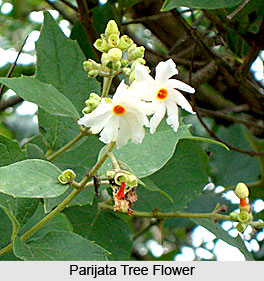 Parijata Tree is known as Adansonia digitata in botanical terms. This tree has been kept in a special category as it does not produce either fruit or seeds. This tree is a unisex male tree. The leaves of Parijat tree in the lower portion have five tips like the fingers of a hand, while at the upper reaches it has seven. Parijat flower is very beautiful and white in colour, on drying out it takes on golden tinge. The flowers have five petals. This tree blossoms rarely, with very few flowers. It spreads its fragrance far and wide when it blossoms after the `Ganga Dashehra`. The height of the tree is said to be around 45 feet and the perimeter is approximately around 50 feet. This tree lives a life span of 1000 to 5000 years.
Parijata Tree is known as Adansonia digitata in botanical terms. This tree has been kept in a special category as it does not produce either fruit or seeds. This tree is a unisex male tree. The leaves of Parijat tree in the lower portion have five tips like the fingers of a hand, while at the upper reaches it has seven. Parijat flower is very beautiful and white in colour, on drying out it takes on golden tinge. The flowers have five petals. This tree blossoms rarely, with very few flowers. It spreads its fragrance far and wide when it blossoms after the `Ganga Dashehra`. The height of the tree is said to be around 45 feet and the perimeter is approximately around 50 feet. This tree lives a life span of 1000 to 5000 years.
Mythology Related to Parijata Tree
The origin of Parijata Tree is basically mythical. Besides this Parijat tree can be found in
The village of Kintoor, near Barabanki district, Uttar Pradesh. It is said that Parijat tree grew from Kunti`s ashes. There are various legends related to this tree. As per legends, Arjuna brought this tree from heaven and Kunti used to offer and crown Lord Shiva with its flowers. Another saying is that in longing for his wife Satyabhama Lord Krishna carried off this tree from the gardens of Lord Indra. Sachi compelled Indra to prevent its removal. A conflict that ensued between the gods and Krishna is described at lengths in the Vishnu Purana. Krishna was victorious, and took the tree to Dwaraka where it was planted in Satyabhama`s garden. When Krishna discarded his mortal body the tree proceeded to heaven again along with the Sudharman palace. It is further said that Parijata tree is a celestial tree produced at Samudra Manthan.
Uttar Pradesh government formed a four member expert committee to save these ancient, historical and religious trees from a dying condition due to being affected by moth and other insects in October, 2010.



















